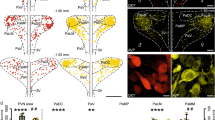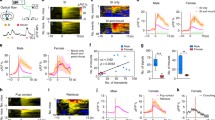Abstract
Despite extensive characterization of sex differences in the medial preoptic area (mPOA) of the hypothalamus, we know surprisingly little about whether or how male and female mPOA neurons differ electrophysiologically, especially in terms of neuronal firing and behavioral pattern generation. In this study, by performing whole-cell patch clamp recordings of the mPOA, we investigated the influences of sex, cell type, and gonadal hormones on the electrophysiological properties of mPOA neurons. Notably, we uncovered significant sex differences in input resistance (male > female) and in the percentage of neurons that displayed post-inhibitory rebound (male > female). Furthermore, we found that the current mediated by the T-type Ca2+ channel (IT), which is known to underlie post-inhibitory rebound, was indeed larger in male mPOA neurons. Thus, we have identified salient electrophysiological properties of mPOA neurons, namely IT and post-inhibitory rebound, that are male-biased and likely contribute to the sexually dimorphic display of behaviors.





Similar content being viewed by others
References
Newman SW. The medial extended amygdala in male reproductive behavior. A node in the mammalian social behavior network. Ann N Y Acad Sci 1999, 877: 242–257.
O’Connell LA, Hofmann HA. Evolution of a vertebrate social decision-making network. Science 2012, 336: 1154–1157.
Zha X, Xu X. Dissecting the hypothalamic pathways that underlie innate behaviors. Neurosci Bull 2015, 31: 629–648.
Campi KL, Jameson CE, Trainor BC. Sexual dimorphism in the brain of the monogamous california mouse (peromyscus californicus). Brain Behav Evol 2013, 81: 236–249.
Gorski RA, Gordon JH, Shryne JE, Southam AM. Evidence for a morphological sex difference within the medial preoptic area of the rat brain. Brain Res 1978, 148: 333–346.
Orikasa C, Sakuma Y. Estrogen configures sexual dimorphism in the preoptic area of C57BL/6J and ddN strains of mice. J Comp Neurol 2010, 518: 3618–3629.
Panzica GC, Viglietti-Panzica C, Balthazart J. The sexually dimorphic medial preoptic nucleus of quail: a key brain area mediating steroid action on male sexual behavior. Front Neuroendocrinol 1996, 17: 51–125.
Hofman MA, Swaab DF. The sexually dimorphic nucleus of the preoptic area in the human brain: a comparative morphometric study. J Anat 1989, 164: 55–72.
Swaab DF, Fliers E. A sexually dimorphic nucleus in the human brain. Science 1985, 228: 1112–1115.
Raisman G, Field PM. Sexual dimorphism in the neuropil of the preoptic area of the rat and its dependence on neonatal androgen. Brain Res 1973, 54: 1–29.
Sickel MJ, McCarthy MM. Calbindin-d28k immunoreactivity is a marker for a subdivision of the sexually dimorphic nucleus of the preoptic area of the rat: developmental profile and gonadal steroid modulation. J Neuroendocrinol 2000, 12: 397–402.
Ayoub DM, Greenough WT, Juraska JM. Sex differences in dendritic structure in the preoptic area of the juvenile macaque monkey brain. Science 1983, 219: 197–198.
Simerly RB, Swanson LW, Gorski RA. Demonstration of a sexual dimorphism in the distribution of serotonin-immunoreactive fibers in the medial preoptic nucleus of the rat. J Comp Neurol 1984, 225: 151–166.
Xu X, Coats JK, Yang CF, Wang A, Ahmed OM, Alvarado M, et al. Modular genetic control of sexually dimorphic behaviors. Cell 2012, 148: 596–607.
Gao SC, Wei YC, Wang SR, Xu XH. Medial preoptic area modulates courtship ultrasonic vocalization in adult male mice. Neurosci Bull 2019, 35: 697–708.
Wei YC, Wang SR, Jiao ZL, Zhang W, Lin JK, Li XY, et al. Medial preoptic area in mice is capable of mediating sexually dimorphic behaviors regardless of gender. Nat Commun 2018, 9: 279.
Wu Z, Autry AE, Bergan JF, Watabe-Uchida M, Dulac CG. Galanin neurons in the medial preoptic area govern parental behaviour. Nature 2014, 509: 325–330.
Brumberg JC, Nowak LG, McCormick DA. Ionic mechanisms underlying repetitive high-frequency burst firing in supragranular cortical neurons. J Neurosci 2000, 20: 4829-4843.
Tripathy SJ, Toker L, Li B, Crichlow CL, Tebaykin D, Mancarci BO, et al. Transcriptomic correlates of neuron electrophysiological diversity. PLoS Comput Biol 2017, 13: e1005814.
Zhang W, Fan BQ, Agarwal D, Li T, Yu YG. Axonal sodium and potassium conductance density determines spiking dynamical properties of regular- and fast-spiking neurons. Nonlinear Dyn 2019, 95: 1035–1052.
Platkiewicz J, Brette R. A threshold equation for action potential initiation. PLoS Comput Biol 2010, 6: e1000850.
Pan MK, Kuo SH, Tai CH, Liou JY, Pei JC, Chang CY, et al. Neuronal firing patterns outweigh circuitry oscillations in parkinsonian motor control. J Clin Invest 2016, 126: 4516–4526.
Stagkourakis S, Spigolon G, Williams P, Protzmann J, Fisone G, Broberger C. A neural network for intermale aggression to establish social hierarchy. Nat Neurosci 2018, 21: 834–842.
Yang Y, Cui Y, Sang K, Dong Y, Ni Z, Ma S, et al. Ketamine blocks bursting in the lateral habenula to rapidly relieve depression. Nature 2018, 554: 317–322.
Cao J, Dorris DM, Meitzen J. Electrophysiological properties of medium spiny neurons in the nucleus accumbens core of prepubertal male and female Drd1a-tdTomato line 6 BAC transgenic mice. J Neurophysiol 2018, 120: 1712–1727.
Dorris DM, Cao J, Willett JA, Hauser CA, Meitzen J. Intrinsic excitability varies by sex in prepubertal striatal medium spiny neurons. J Neurophysiol 2015, 113: 720–729.
Piet R, Boehm U, Herbison AE. Estrous cycle plasticity in the hyperpolarization-activated current ih is mediated by circulating 17beta-estradiol in preoptic area kisspeptin neurons. J Neurosci 2013, 33: 10828–10839.
Wang L, DeFazio RA, Moenter SM. Excitability and burst generation of avpv kisspeptin neurons are regulated by the estrous cycle via multiple conductances modulated by estradiol action. eNeuro 2016, 3.
Hodgkiss JP, Kelly JS. An intracellular study of grafted and in situ preoptic area neurones in brain slices from normal and hypogonadal mice. J Physiol 1990, 423: 111–135.
Hoffman NW, Kim YI, Gorski RA, Dudek FE. Homogeneity of intracellular electrophysiological properties in different neuronal subtypes in medial preoptic slices containing the sexually dimorphic nucleus of the rat. J Comp Neurol 1994, 345: 396–408.
Surges R, Sarvari M, Steffens M, Els T. Characterization of rebound depolarization in hippocampal neurons. Biochem Biophys Res Commun 2006, 348: 1343–1349.
McLean AC, Valenzuela N, Fai S, Bennett SA. Performing vaginal lavage, crystal violet staining, and vaginal cytological evaluation for mouse estrous cycle staging identification. J Vis Exp 2012: e4389.
Fujita A, Bonnavion P, Wilson MH, Mickelsen LE, Bloit J, de Lecea L, et al. Hypothalamic tuberomammillary nucleus neurons: electrophysiological diversity and essential role in arousal stability. J Neurosci 2017, 37: 9574–9592.
Karagiannis A, Gallopin T, David C, Battaglia D, Geoffroy H, Rossier J, et al. Classification of npy-expressing neocortical interneurons. J Neurosci 2009, 29: 3642–3659.
Li XY, Han Y, Zhang W, Wang SR, Wei YC, Li SS, et al. Agrp neurons project to the medial preoptic area and modulate maternal nest-building. J Neurosci 2019, 39: 456–471.
Pfeffer CK, Xue M, He M, Huang ZJ, Scanziani M. Inhibition of inhibition in visual cortex: the logic of connections between molecularly distinct interneurons. Nat Neurosci 2013, 16: 1068–1076.
Moffitt JR, Bambah-Mukku D, Eichhorn SW, Vaughn E, Shekhar K, Perez JD, et al. Molecular, spatial, and functional single-cell profiling of the hypothalamic preoptic region. Science 2018, 362: eaau5324.
Bosch MA, Hou J, Fang Y, Kelly MJ, Ronnekleiv OK. 17Beta-estradiol regulation of the mRNA expression of T-type calcium channel subunits: role of estrogen receptor alpha and estrogen receptor beta. J Comp Neurol 2009, 512: 347–358.
Qiu J, Bosch MA, Jamali K, Xue C, Kelly MJ, Ronnekleiv OK. Estrogen upregulates T-type calcium channels in the hypothalamus and pituitary. J Neurosci 2006, 26: 11072–11082.
Zhang C, Bosch MA, Rick EA, Kelly MJ, Ronnekleiv OK. 17Beta-estradiol regulation of T-type calcium channels in gonadotropin-releasing hormone neurons. J Neurosci 2009, 29: 10552–10562.
Anderson MP, Mochizuki T, Xie J, Fischler W, Manger JP, Talley EM, et al. Thalamic Cav3.1 T-type Ca2+ channel plays a crucial role in stabilizing sleep. Proc Natl Acad Sci U S A 2005, 102: 1743–1748.
Tai CH, Yang YC, Pan MK, Huang CS, Kuo CC. Modulation of subthalamic T-type Ca2+ channels remedies locomotor deficits in a rat model of parkinson disease. J Clin Invest 2011, 121: 3289–3305.
Ferrante M, Shay CF, Tsuno Y, William Chapman G, Hasselmo ME. Post-inhibitory rebound spikes in rat medial entorhinal layer ii/iii principal cells: in vivo, in vitro, and computational modeling characterization. Cereb Cortex 2017, 27: 2111–2125.
Kim J, Kim Y, Nakajima R, Shin A, Jeong M, Park AH, et al. Inhibitory basal ganglia inputs induce excitatory motor signals in the thalamus. Neuron 2017, 95: 1181–1196 e1188.
Large EW, Crawford JD. Auditory temporal computation: interval selectivity based on post-inhibitory rebound. J Comput Neurosci 2002, 13: 125–142.
Picton LD, Sillar KT, Zhang HY. Control of xenopus tadpole locomotion via selective expression of Ih in excitatory interneurons. Curr Biol 2018, 28: 3911–3923 e3912.
Rubinow DR, Schmidt PJ. Sex differences and the neurobiology of affective disorders. Neuropsychopharmacology 2019, 44: 111–128.
Acknowledgements
This work was supported by Grants from the National Natural Science Foundation of China (31871066, 31922028 and 31900721), Shanghai Municipal Science and Technology Major Project (2018SHZDZX05) and the Strategic Priority Research Program of the Chinese Academy of Sciences (XDB32000000). We thank Dr. Yuguo Yu from Fudan University for providing some MatLab codes used in analysis.
Author information
Authors and Affiliations
Corresponding author
Ethics declarations
Conflict of interest
The authors claim no conflict of interest.
Electronic supplementary material
Below is the link to the electronic supplementary material.
Rights and permissions
About this article
Cite this article
Zhang, W., Li, Ss., Han, Y. et al. Sex Differences in Electrophysiological Properties of Mouse Medial Preoptic Area Neurons Revealed by In Vitro Whole-cell Recordings. Neurosci. Bull. 37, 166–182 (2021). https://doi.org/10.1007/s12264-020-00565-9
Received:
Accepted:
Published:
Issue Date:
DOI: https://doi.org/10.1007/s12264-020-00565-9




